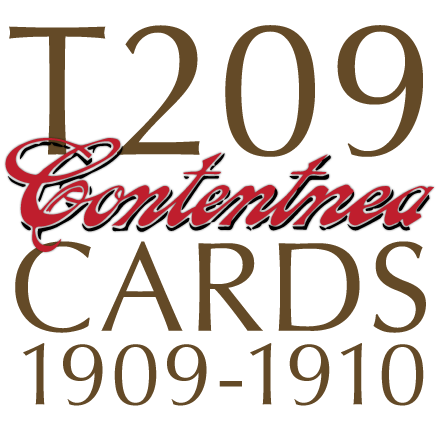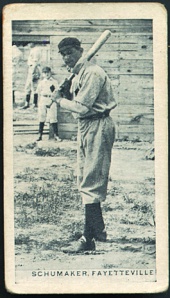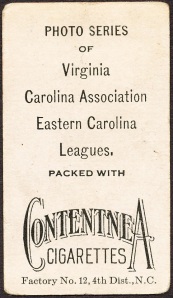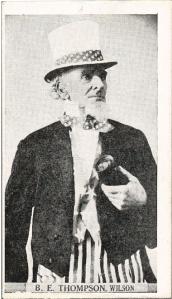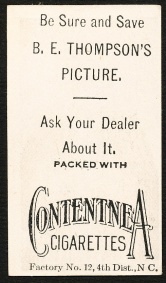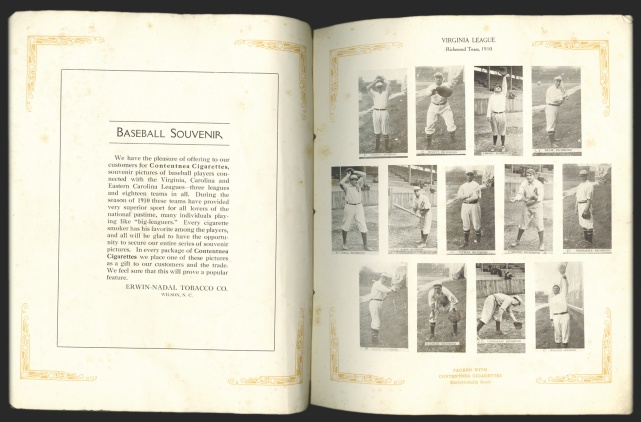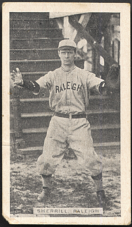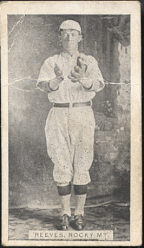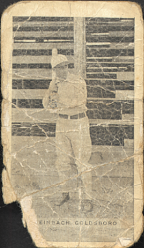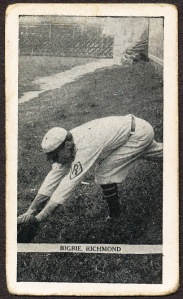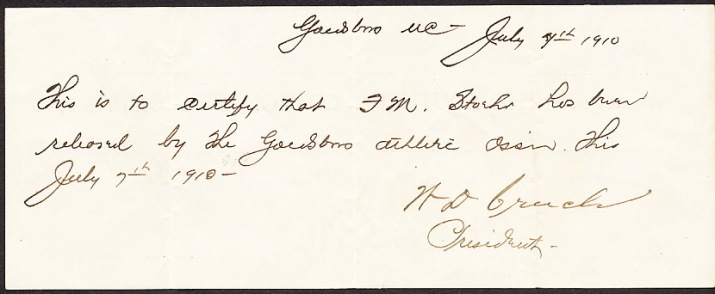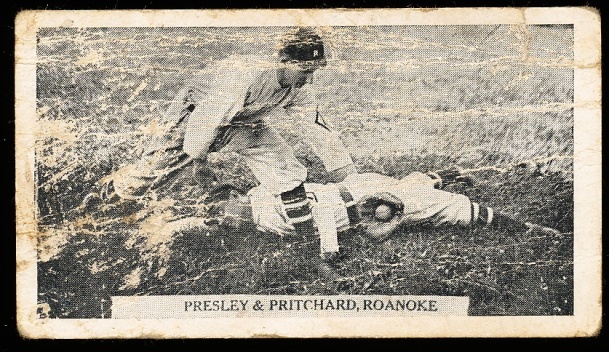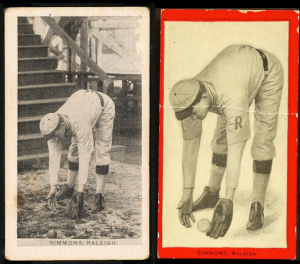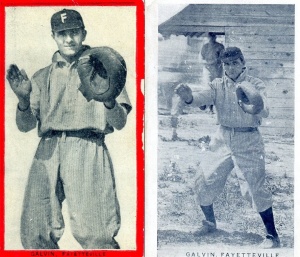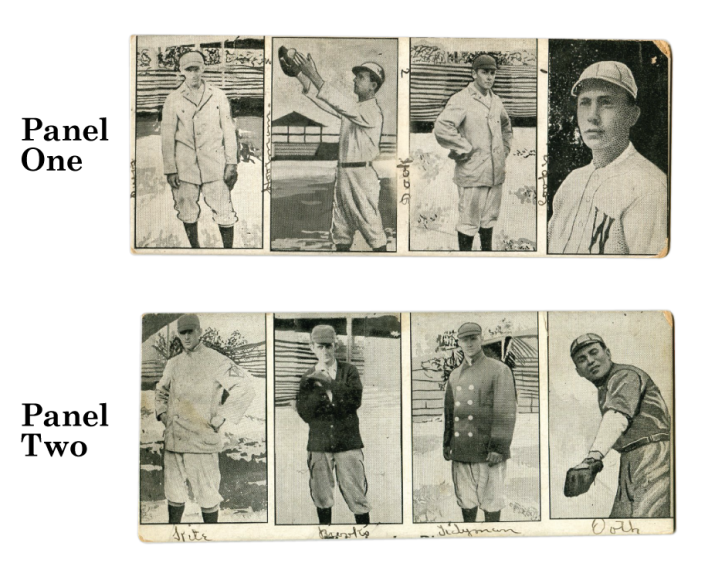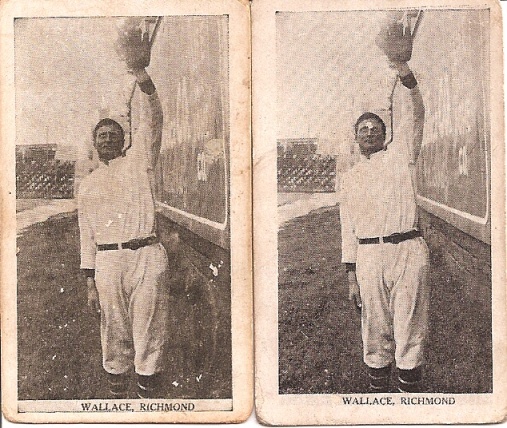Although the players are once again from the Carolina Association, Eastern Carolina and Virginia Leagues, Erwin-Nadal’s “Photo Series” issue for the 1910 season looks very different from the 1909 set. Series Two cards consist of black and white photographic images printed on slightly larger stock, 1 5/8” X 2 3/4”. Again included in packs of Contentnea Cigarettes, they are among the first twentieth century baseball cards to feature photos of players both on the field of play and in studio settings, reminiscent of N172 (Old Judge).
Though the second series of T209 contains fewer inconsistencies than the first, one basic question has vexed collectors for years: How many cards are actually in the set? In his Encyclopedia of Baseball Cards Lew Lipset claims 222, although he omitted a player name for #179, making it 221. The Standard Catalogue lists 223, and a recently discovered album printed by Erwin-Nadal in 1910 pictures 212. Some advanced collectors have maintained that there may be as many as 225. We believe that there are 224 cards in the set. Our estimate subtracts three cards typically checklisted that we suspect do not exist, and adds three cards never before checklisted whose existence is now firmly established.
Unlike Series One, which was hastily assembled during the 1909 season to capitalize on the collecting craze inspired by T206, the second series was carefully planned before the 1910 season commenced. The use of black and white photographs, less expensive to reproduce than color lithographs, made it possible to depict a much more comprehensive representation of North Carolina and Virginia players. By increasing the number of cards and the number of teams represented, Erwin-Nadal sought to broaden its reach throughout the Carolinas region. This time the manufacturers made certain that the government mandated factory designation was printed on the back of each card. The company also designed and produced a photo album to allow collectors to keep track of their holdings, and to know which cards they still lacked.
Players of Series Two: Major Leaguers & B. E. Thompson
Most of the players in Series Two never played above the minor leagues, but 27 enjoyed at least a cup of coffee in the majors, including Lave Cross, Walter Schmidt, Tillie Walker and Ivey Wingo. Erwin-Nadal missed the opportunity to include Jim Thorpe, who began the 1910 season with the Rocky Mount Railroaders where he compiled a 10-10 pitching record, and finished with the Fayetteville Highlanders who used him at first base. (See Major Leaguers here.)
Surprisingly, only 5 of the 16 players depicted in T209-Series One are represented in the second set, and four of them, Armstrong, Cowell, Lane, and Dan McGeehan played for Wilson, while former teammate John Cooper played with Wilmington.
Another curiosity of the set is the Wilson card depicting B. E. Thompson, a non-player dressed in an Uncle Sam costume. Benjamin Thompson was a Civil War veteran, and a prominent Wilson tobacco farmer; his inclusion in the set suggests that he was a local celebrity who sold leaf to Erwin-Nadal.1
The back of Thompson’s card depicts the Contentnea logo and encourages recipients to take the card to their “dealer,” presumably to redeem it for a premium. Collectors have speculated that the premium may have been a pocket-knife, a lighter, or additional Series Two cards. We believe that the premium was the album pictured below, recently discovered by a long-time collector. Entitled “Baseball Souvenir,” the album depicts all eighteen teams represented in the set, 211 of the player cards, and B. E. Thompson.
The concept of redeeming a coupon for an album was borrowed from late 19th century tobacco companies. For example, Allen & Ginter’s Champions (1888) featuring N28 and N43, or Goodwin & Company’s Champions (1888) showing N162, were popular baseball collectibles similar to Contentnea’s album.
Although there is no clear date for when it was issued, several clues suggest that the album was probably issued after the mid point of the 1910 season. As we discuss in “Players of Series Two: Checklist” (see below) some of the players depicted in the album had changed teams by the middle of the season. (See Chart A here.) Additionally, twelve player cards issued by Contentnea were not shown in the album. Further, the Introduction to the album is written in the past tense suggesting that those who saved cards had already enjoyed watching some of the players perform their diamond magic: “During the season of 1910 these teams have provided very superior sport for all lovers of the national pastime, many individuals playing like `big-leaguers.’”
The most obvious clue is the Portsmouth team. It is listed in the album as the Portsmouth-Petersburg Team, a clear indication that the album appeared after July 1, the day the Virginia League moved the Portsmouth team to Petersburg, VA. (See album here.)
The album’s mid-season release raises another question: If Portsmouth’s name was changed in the album to reflect the move to Petersburg after July 1, why didn’t Erwin-Nadal make certain that the players in the album still played for their designated teams? There are two facts to consider. First, the album is composed of cards Erwin-Nadal produced before the season began. We seriously doubt that the person who oversaw production of the album was aware that about 30 players were no longer with the teams pictured on their cards. Communication was much slower in 1910 than it is over one hundred years later.
Secondly, it would have been time consuming, and expensive to make extensive changes to the album. The B. E. Thompson card had probably been released with the regular player cards so Erwin-Nadal had to have a redemption item ready for tobacco purveyors. That meant the album was probably in early production shortly after the season began on April 26. No doubt those responsible found it much easier to change a team’s name than to fact-check players, and revise the entire layout with new player information.
Player Cards
The back on most examples of the B. E. Thompson card display the printed factory designation that is found on all player cards in the set. However, there are at least three back variations, suggesting that his card and the player cards were issued early in 1910.
In the first example below the factory information has been omitted (A), only to be hand applied (with a stamp similar to Series One) in the next example (B). Erwin-Nadal may have assumed the factory designation was not required on the Thompson card since it was a redeemable premium, different from the player poses. Federal officials must have disagreed and made the manufacturer add the factory stamp. Most likely the company hurriedly hand stamped the cards that were already printed, and then added the printed information to coupon cards issued later (C). The fourth example (D) is a curiosity. It contains the printed factory designation, but the back has a thin border created by a single line. No one has seen another bordered example, and this example may have been either a printer’s error or a rejected prototype.
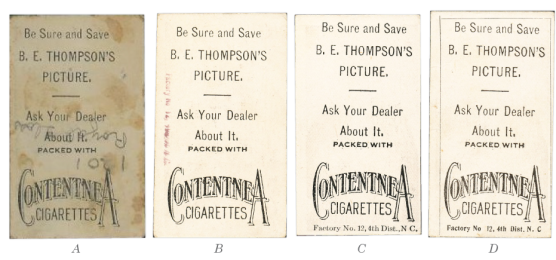
Players of Series Two: Checklist
The large lot of T209-II that belonged to hobby legend Joe Pelaez (offered by Robert Edward Auctions in May 2012), contained three previously unknown cards: Reeves, E. A. Sherrill and William Steinbach. Sherrill, who was briefly a member of the Raleigh Redbirds, left for another team. The Raleigh Evening Times (June 10, 1910) notes that when the season was barely a few weeks old, Sherrill asked for his release to join the Morristown (TN) Jobbers of the Class D Southeastern League. Presumably his card is scarce because of his defection from Raleigh.
Reeves (Rocky Mount) and Steinbach (Goldsboro) appear both in the album and in the Pelaez collection, but have never previously been checklisted. Steinbach was with Goldsboro when the 1910 season opened, but left the team on June 2, ten days after the season began. Reeves had played for Richmond in 1907 but does not appear on their roster at the beginning of the 1910 season. He, like Steinbach and many others, may have been released by the team, or asked for his release, after the season began.
Our best guess is that photos had been taken of the players and the first printing of cards had already been completed by the time the three were released, leaving their cards in circulation. Because they were no longer playing, their cards were not as highly prized and thus fewer cards have survived.
On the other hand, we are reasonably certain that three previously listed cards, Crockett, Pressley, and Wolf, don’t exist. Davey Crockett did play for Goldsboro (1909 & 1910) and was one of sixteen players included in Series One. Additionally, Wolf is often checklisted as Crockett’s teammate in Goldsboro, but William Wolf played 23 games for Rocky Mount in 1910 and is not listed on Goldsboro’s team roster. Advanced collectors have never seen either player’s Series Two card, and that questions their existence.
Similarly, “Buck” Pressley is one half of the only double card in the set. Some collectors have theorized that Buck must have had a separate Series Two card since Pritchard had one, but Pressley doesn’t exist. If any collector can supply evidence of these cards, we will gratefully report on that fact.
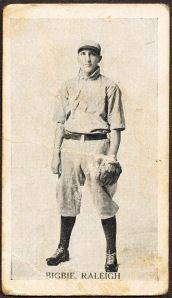
Bigbie (Raleigh)
Another interesting player is second baseman Fred Bigbie, who has two cards in the set. His Raleigh card is pictured in the album, while the one with Richmond is not. Fred started the season in Raleigh of the Eastern Carolina League, and switched to Spartanburg in the Carolina Association. With the season almost half over he moved up to Class C Richmond (Virginia League), and finished the year with Norfolk. The presence of his Raleigh card is further evidence that the album was produced with cards bearing photos taken early in the season.
All 212 of the players depicted in the album have a corresponding card, but there are twelve cards known to exist that do not appear in the album. Two of them, Sherrill and Bigbie (Richmond), have already been discussed. Why did the other ten not appear in the album? One explanation, by Keith Olbermann, is based on the page space available for cards in the album. Each team is allotted one page, and none has more than thirteen players on its page. The inclusion of the Raleigh Redbirds players Beatty, Hart, King Kelly, Mundell, Prim, and Wright would have created a page with nineteen players. Similarly, displaying the Goldsboro Giants’ Kelly and Stoehr would have made fifteen players.
The remaining two players not found in the album are less clear. Charles Armstrong (Norfolk) played with the Tars in 1907, but there is no record of him with Norfolk in 1910. He is displayed in the album as a member of the Wilson Tobacconists, and his recently discovered Wilson card affirms this. The final excluded player, Curtis Walker (Norfolk), played one season in the minors, compiling a 7-8 pitching record with the Tars in 1910. In all likelihood he was a late roster addition after photos for the album had been completed.
The question of team affiliation for many players in the Second Series speaks to the larger issue of stability among team rosters during this era. It appears that minor league rosters were in constant flux through addition and attrition. Teams were looking to upgrade and regularly tried out new players, often signing them and releasing roaster players. Similarly, players requested their release in order to join another team, or to return to their lives outside of baseball. Because there was no uniform collective bargaining agreement between management and subordinates, players were at the mercy of their owners.
A recently discovered archive of letters written by southern league pitcher Fred Stoehr provides a first-person glimpse of life in the southern minor leagues (1908-1910).2 Stoehr, a right-handed hurler from Altoona, PA, joined the Goldsboro Giants early in 1909 after being released by the Roanoke Tigers. He went 16-13 for the Giants in 1909, signed a contract to pitch for Goldsboro during the 1910 campaign, and was the opening day pitcher in a win over Wilmington on May 26. Despite his early success the season did not go well for Stoehr and by mid-June he complained to his wife about losing. He blamed his losses on inadequate hitting and fielding by his teammates, and began talking of moving to another team. (Does this sound familiar?!). On June 2 he remarked that his manager, Kelly, had been released, and that Steinbach had left the team to return home with his wife. (View the Stoehr letter of June 2, 1910 here.)
The Giants were losing more than they were winning and on July 7 Stoehr asked for and was granted his release by Giants’ president, W. D. Creech. Three days later he joined the Wilmington Sailors and pitched the final two innings in a 2-8 loss at Raleigh. There is not much information about him after his final letter, July 15. In that letter he mentions that a number of players will be released, and he may have been one of them. The Stoehr letters depict life in the minors, including the reality that players constantly moved around the minor leagues. (View the Stoehr letter of July 8, 1910 here.)
One other interesting bit of information in the letters is Stoehr’s oblique references to his having sent a “card” with a letter he wrote to someone. Could the “card” have been his Contentnea baseball card? He never says more about this card, nor does he mention player photos being taken. One can assume, however, that since his T209 card affiliation is with Goldsboro, his photo was probably taken early in the season and the card printed well before his release in early July.
Frequent player movement, as typified by Stoehr, helps explain why it is difficult to establish who played for whom with respect to baseball cards for southern minor leaguers. By the time a player card was issued, there was a very good chance that player was no longer a member of the team listed on his card. (That was also the case for T210 Old Mill cards, but they will be discussed in a future post.)
Player Photographs: Overview
The photographs used for T209 are interesting not only for their poses, but also for their provenance. The subjects are arranged in three categories:
- portrait photos of players seated in a studio (Charlotte, Danville, Greensboro, Greenville, and Winston-Salem);
- studio photos of players posed in action shots against a standard backdrop (Raleigh, Rocky Mount, and Wilmington);
- stadium photos of players posed in action shots (Anderson, Fayetteville, Goldsboro, Lynchburg, Norfolk, Portsmouth, Richmond, Roanoke, Spartanburg, and Wilson).
There are exceptions. In the studio pose category Wilmington’s John Cooper appears in a stadium pose. Five Raleigh players (Bigbie, Hawkins, Hobbs, McCormack and Richardson) appear with no studio background image. Because the peripatetic Bigbie is one of them, these five players were probably added to the roster after the studio sessions, and the backgrounds brushed out so that each card resembled the posed photos.
Three of the ten teams with stadium poses issued some cards with portrait poses: Goldsboro (Handiboe, Merchant and Morgan), Lynchburg (Brandon and Sexton), and Wilson (C. McGeehan and Stewart). These players all appear in the Souvenir Album so it’s possible that the players were added to the team’s roster after the stadium poses were taken. There is only one horizontal card in the set: Roanoke’s William Pressley and N. Pritchard are depicted in an action shot of Pritchard sliding under Pressley’s tag.
Player Photographs: Source
No evidence exists to document the source of the photographs used for the cards. Studio portraits were presumably taken at local studios before the season began. We speculate that stadium photos were taken by independent photographers who operated throughout the southern leagues and sold their images to multiple cigarette manufacturers.
This view is supported by the appearance of many of the same player images in two other 1910 tobacco sets featuring black and white photographs of southern minor league players: the Red Sun cigarette set of 75 players from the Southern Association (T211), and various series of the giant Old Mill issue (T210). At least 25 T210 Series Seven cards, featuring the Eastern Carolina League where Wilson played, share photos with T209-II. T210 Series 5 (Carolina Association) shares 13 photos with T209-II, and Series 2 (Virginia League) shares 5. (See Shared Poses here.)
The poses on each card are exactly the same, although the T210 version has no stadium background, and occasionally a team’s logo may be superimposed on a player’s shirt, hat or sleeve. In one instance (Simmons), the ball has moved from a few inches away (T209-2) into his glove (T210-7). The two Galvin poses are interesting because even though they look alike, the T209 version seems to have been taken a few frames later than its T210 counterpart. This slight variation suggests that the photographer offered several poses for each player from which the manufacturer chose one.
The two panels of player photographs mentioned in the First Series Overview represent further evidence for the work of independent photographers:
A broker for the photographer (possibly the photographer himself) would show a customer, like Erwin-Nadal, printed player images from which the manufacturer would choose a player pose to appear on their cards. It is possible that these two surviving panels were cut from sample sheets of the broker’s player image inventory.
Each panel contains four player photos printed horizontally, with hand-written names identifying each photo. The hand-written identification would be similar to player identifications written on the back of early photographs taken by Carl Horner or Paul Thompson. In this case the player IDs were written next to their image. (See Series One Overview here for photo proof discussion.)
Printed in Wilson
We suspect Series Two cards, like Series One, were locally manufactured in or near Wilson. The caption box at the bottom of each T209 card is carelessly and inconsistently placed as demonstrated in the examples shown in the Team Gallery. (See team galleries here for examples.) At least two players, Wallace and Armstrong, have cards that don’t include a caption frame. Compared to the snazzy colored borders and more finished captioning formats of the Old Mill and Red Sun cards, the captioning and relatively crude white-border format of T209-II suggests a printing house that was a good bit further away from the state of the art in 1910.
Conclusion
Both series of T209 are worthy of pursuit for several reasons. Serious collectors and students of baseball history will welcome the opportunity to learn more about interesting, less prominent southern league players. Those interested in the development of baseball cards will appreciate that Series Two represents an early example of the shift away from color lithographic player images to the use of real photographs. The stadium photos are particularly notable in this regard. And for those who enjoy the challenge of finding scarce cards, this two-year issue (Contentnea ceased production in 1912) will provide ample opportunities to engage in the hunt.
Series One, despite containing just 16 cards, is challenging to complete because of the obscure players depicted in the set. And despite the discovery of the Reeves, Sherrill and Steinbach cards, Series Two is also a formidable collecting challenge. To date we are unaware of any complete collections.
We think T209 I & II have great collector appeal and hope you will take a look at two underappreciated sets.
Michael Peich & Tim Newcomb
Old Cardboard (Issue #28, Fall 2012)
Revised March 2014
Endnotes:
1. McAdams, Robert C. The Tobacco Culture of Wilson County, North Carolina. Knoxville, Tennessee: University of Tennessee, 1996.
2. Michael Peich acquired an archive of letters written by Frederick M. Stoehr to his fiance, later his wife, during the seasons of 1908-1910. Stoehr played for the Roanoke, Anderson, Goldsboro and Wilmington teams in the southern minor leagues.
3. Keith Olbermann generously shared information about Series Two. Thanks also to John Esch, Rob Lifson, Leon Luckey, Bob Marquette, Richard Masson, Jay Miller, Russell “Rusty” Rains (Wilson County Library, Wilson, NC), Zach Rice, Jim Rivera, Jeremy Wagoner, and Brian Weisner for sharing information and images.
